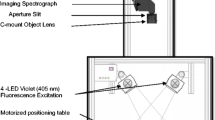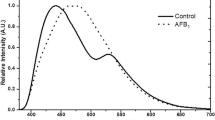Abstract
Food safety in the production of fresh produce for human consumption is a worldwide issue and needs to be addressed to decrease foodborne illnesses and resulting costs. Hyperspectral fluorescence imaging coupled with multivariate image analysis techniques for detection of fecal contaminates on spinach leaves (Spinacia oleracea) was evaluated. Violet fluorescence excitation was provided at 405 nm and light emission was recorded from 464 to 800 nm. Partial least square discriminant analysis and wavelength ratio methods were compared for detection accuracy for fecal contamination. Fluorescence emission profiles of spinach leaves were monitored over a 27 days storage period; peak emission blue-shifts were observed over the storage period accompanying a color change from green to green–yellow–brown hue. The PLSDA model developed correctly detected fecal contamination on 100 % of relatively fresh green spinach leaves used in this investigation, which also had soil contamination. The PLSDA model had 19 % false positives for non-fresh post storage leaves. A wavelength ratio technique using four wavebands (680, 688, 703 and 723 nm) was successful in identifying 100 % of fecal contaminates on both fresh and non-fresh leaves. An on-line fluorescence imaging inspection system for fecal contaminant detection has potential to allow fresh produce producers to reduce foodborne illnesses and prevent against the associated economic losses.





Similar content being viewed by others
References
CDC, Centers for Disease Control and Prevention Estimates of Foodborne Illness in the United States (2011) http://www.cdc.gov/foodborneburden/surveillance-systems.html. Assessed 9 April 2015
M.T. Brandl, Plant lesions promote the rapid multiplication of Escherichia coli O157:H7 on postharvest lettuce. Appl. Environ. Microbiol. 74(17), 5285–5289 (2008)
USFDA, Guidance for Industry, Guide to Minimize Microbial Food Safety Hazards of Leafy Greens. (United States Department of Health and Human Services, United States Food and Drug Administration, Center for Food Safety and Applied Nutrition, Washington, DC, USA, 2009)
D. Ivnitski, I. Abdel-Hamid, P. Atanasov, E. Wilkins, Biosensors for detection of pathogenic bacteria. Biosens. Bioelectron. 14(7), 599–624 (1999)
M.T. Madigan, J.M. Martinko, J. Parker, Brock Biology of Microorganisms, 8th edn. (A Viacom Company, Upper Saddle River, 1997), p. 986
R.L. Buchanan, M.P. Doly, Foodborne disease significance of E. c oli O157:H7 and other enterohemorrhagic E. c oli. Food Technol. 51(10), 69–76 (1997)
P.C. Rowe, E. Orrbine, G.A. Well, Epidemiology of hemolytic-uremic syndrome in Canadian children from 1986 to 1988. J. Pediatr. 119, 218–224 (1991)
A.E. Greenberg, R.R. Trussel, L.S. Clesceri, M.A.H. Franson, Standard Methods for the Examination of Water and Wastewater (American Public Health Association, Washington, 1992)
M. Tietjen, D.Y.C. Fung, Salmonella and food safety. Crit. Rev. Microbiol. 21, 53–83 (1995)
M. Severgnini, P. Cremonesi, C. Consolandi, G. DeBellis, B. Castiglioni, Advances in DNA microarray technology for the detection of foodborne pathogens. Food Bioprocess Technol. 4, 936–953 (2011)
O. Reichart, K. Szakmár, Á. Jozwiak, J. Felföldi, L. Baranyai, Redox potential measurement as a rapid method for microbiological testing and its validation for coliform determination. Int. J. Food Microbiol. 114, 143–148 (2007)
D.I. Murdock, C.H. Brokaw, Some specific source of contamination in processing frozen concentrated orange juice. 1. Handling and preparing fruit for extraction. In: Proceedings of the Florida State Horticultural Society, 70:231–237 (1957)
USFDA. Analysis and evaluation of prevention control measures for the control and reduction/elimination of microbial hazards on fresh and fresh-cut produce (2001). http://www.cfsan.fda.gov. Accessed 9 April 2015
J. Xicohtencatl-Cort, E.S. Chacon, Interaction of Escherichia coli O157:H7 with leafy green produce. J. Food Prot. 72(7), 1531–1537 (2009)
S. Kang, K. Lee, J. Son, M.S. Kim, Detection of fecal contamination on leafy greens by hyperspectral imaging. Procedia Food Sci. 1, 953–959 (2011)
M.S. Kim, Y.R. Chen, P.M. Mehl, Hyperspectral reflectance and fluorescence imaging system for food quality and safety. Trans. ASAE 44(3), 721–729 (2001)
C.D. Everard, M.S. Kim, H. Lee, A comparison of hyperspectral reflectance and fluorescence imaging techniques for detection of contaminants on spinach leaves. J. Food Eng. 143, 139–145 (2014)
M.S. Kim, A.M. Lefcourt, Y.R. Chen, Y. Tao, Automated detection of fecal contamination of apples based on multispectral fluorescence image fusion. J. Food Eng. 71, 85–91 (2005)
M.S. Kim, A.M. Lefcourt, Y.R. Chen, Y. Tao, Optimal fluorescence excitation and emission bands for detection of fecal contamination. J. Food Prot. 66(7), 1198–1207 (2003)
X. Lu, H.M. Al-Qadiri, M. Lin, B.A. Rasco, Application of mid-infrared and Raman spectroscopy to the study of bacteria. Food Bioprocess Technol. 4, 919–935 (2011)
A.A. Gowen, M. Taghizadeh, C.P. O’Donnell, Identification of mushrooms subjected to freeze damage using hyperspectral imaging. J. Food Eng. 93(1), 7–12 (2009)
A.M. Vargas, M.S. Kim, Y. Tao, A.M. Lefcourt, Y.R. Chen, Y. Luo, Y. Song, R. Buchanan, Detection of fecal contamination on cantaloupes using hyperspectral fluorescence imagery. J. Food Sci. 70(8), 471–476 (2005)
Y.R. Chen, K. Chao, M.S. Kim, Machine vision technology for agricultural applications. Comput. Electron. Agric. 36, 173–191 (2002)
M.S. Kim, K. Lee, K. Chao, A.M. Lefcourt, W. Jun, D.E. Chan, Multispectral line-scan imaging system for simultaneous fluorescence and reflectance measurements of apples. Sens. Instrum. Food Qual. Saf. 2(2), 123–129 (2008)
A. Walkley, I.A. Black, An examination of the Degtjareff method for determining soil organic matter and a proposed modification of the chromic acid titration method. Soil Sci. 37, 29–38 (1934)
J. Xing, W. Saeys, J. DeBaerdemaeker, Combination of chemometric tools and image processing for bruise detection on apples. Comput. Electron. Agric. 56, 1–13 (2007)
S. Roussel, V. Bellon-Maurel, J.M. Roger, P. Grenier, Authenticating white grape must variety with classification models based on aroma sensors, FT-IR and UV spectrometry. J. Food Eng. 60, 407–419 (2003)
D. Wang, F.E. Dowell, R.E. Lacey, Single wheat kernel color classification by using near-infrared reflectance spectra. Cereal Chem. 76(1), 30–33 (1999)
C.D. Everard, C.P. O’Donnell, D.J. O’Callaghan, E.M. Sheehan, C.M. Delahunty, B.T. O’Kennedy, V. Howard, Prediction of sensory textural properties from rheological analysis for process cheeses varying in emulsifying salt, protein and moisture contents. J. Sci. Food Agric. 87, 641–650 (2007)
M.S. Kim, J.E. McMurtrey, C.L. Mulchi, C.S.T. Daughtry, E.W. Chappelle, Y.R. Chen, Steady-state multispectral fluorescence imaging system for plant leaves. Appl. Opt. 40, 157–166 (2001)
E.W. Chappelle, F.M. Wood, J.E. McMurtrey, W.W. Newcomb, Laser induced fluorescence of green plants: 1. A technique for the remote detection of plant stress and species differentiation. Appl. Opt. 23, 134–138 (1984)
G. Papageorgiou, Chlorophyll fluorescence: an intrinsic probe of photosynthesis, in Bioenergetics of Photosynthesis, ed. by G. Govindjee (Academic Press, NewYork, 1975), pp. 320–371
B. Diezma, L. Lleó, J.M. Roger, A. Herrero-Langreo, L. Lunadei, M. Ruiz-Altisent, Examination of the quality of spinach leaves using hyperspectral imaging. Postharvest Biol. Technol. 85, 8–17 (2013)
Z.Y. Liy, J.J. Shi, D.C. Wang, J.F. Huang, Discrimination and spectral response characteristic of stress leaves infected by rice Aphelenchoides besseyi Christie. Spectrosc. Spectr. Anal. 30, 710–714 (2010)
L. Xue, L. Yang, Deriving leaf chlorophyll content of green-leafy vegetables from hyperspectral reflectance. ISPRS J. Photogr. Remote Sens. 64, 97–106 (2009)
C.S. Daughtry, C.L. Walthal, M.S. Kim, E.B. DeColstoun, J.E. McMurtrey, Estimating corn leaf chlorophyll concentration from leaf and canopy reflectance. Remote Sens. Environ. 74(2), 229–239 (2000)
G.A. Carter, W.G. Cibula, R.L. Miller, Narrow-band reflectance imagery compared with thermal imagery for early detection of plant stress. J. Plant Physiol. 148(5), 515–520 (1996)
Acknowledgments
This publication has emanated from research conducted with the financial support of the European Union’s Seventh Framework Programme (FP7) under the Marie Curie International Outgoing Fellowships for Career Development (FP7-PEOPLE-2011-IOF).
Author information
Authors and Affiliations
Corresponding author
Rights and permissions
About this article
Cite this article
Everard, C.D., Kim, M.S., Cho, H. et al. Hyperspectral fluorescence imaging using violet LEDs as excitation sources for fecal matter contaminate identification on spinach leaves. Food Measure 10, 56–63 (2016). https://doi.org/10.1007/s11694-015-9276-x
Received:
Accepted:
Published:
Issue Date:
DOI: https://doi.org/10.1007/s11694-015-9276-x




